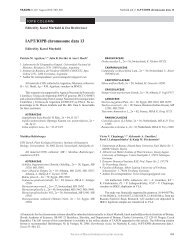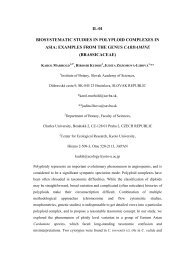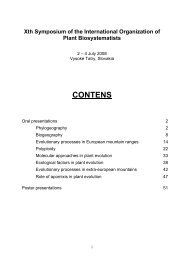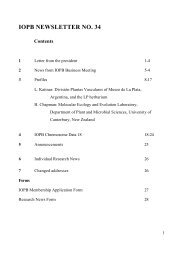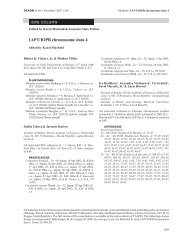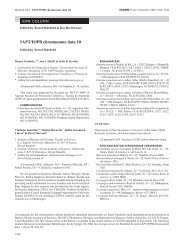iopb newsletter no - International Organization of Plant Biosystematists
iopb newsletter no - International Organization of Plant Biosystematists
iopb newsletter no - International Organization of Plant Biosystematists
Create successful ePaper yourself
Turn your PDF publications into a flip-book with our unique Google optimized e-Paper software.
Main research topics<br />
Gene phylogeny and comparison to<br />
other phylogenetic sources. The aim is to<br />
get an understanding <strong>of</strong> the evolutionary<br />
history <strong>of</strong> the RBP2 gene in flowering<br />
plants, especially gene phylogeny and<br />
macromutational events within the asterids.<br />
Within the asterid group <strong>of</strong> plants, the<br />
interrelationships among the major<br />
groupings are largely unclear. The<br />
distribution <strong>of</strong> duplicate copies and<br />
subsequent loss <strong>of</strong> introns in one <strong>of</strong> the<br />
copies are incongruent with earlier<br />
hypotheses based on cpDNA and nrDNA<br />
sequences. More sequence data and denser<br />
taxon sampling than is presently available<br />
are needed to get a robust gene phylogeny<br />
based on the RPB2 sequences themselves.<br />
Congruence with other sequence regions is<br />
evaluated, and possible recombinational<br />
events are looked for. To get an overall<br />
picture <strong>of</strong> RPB2 gene phylogeny, and to<br />
facilitate future studies <strong>of</strong> other plant<br />
groups,we plan to develop a database <strong>of</strong><br />
<strong>no</strong>n-asterid RPB2 sequences.<br />
Histories <strong>of</strong> allopolyploids as inferred<br />
from molecular phylogenies. The aim <strong>of</strong><br />
this part is to use RPB2 intron sequences as<br />
one source <strong>of</strong> data for inferring the origin<br />
<strong>of</strong> allopolyploid taxa. Most previous<br />
studies <strong>of</strong> allopolyploids are based on<br />
character additivity and/or intermediacy <strong>of</strong><br />
the putative "parental" species. With such<br />
an approach, <strong>no</strong> alternative hypotheses are<br />
tested and it is ambiguous what kind <strong>of</strong><br />
observation would falsify an hypothesis.<br />
By identifying and characterizing<br />
homoeologous DNA regions from the<br />
hypothetical parental lineages, it is possible<br />
to use phylogenetic methods to infer<br />
histories <strong>of</strong> allopolyploid plants. This<br />
approach has been used to test hypothesis<br />
concerning the parental lineages <strong>of</strong> the<br />
allotetraploid Silene aegaea (#7, 23), and<br />
will, in conjuction with other molecular<br />
data sets, be extended to other plant groups<br />
as well. By studying polyploids <strong>of</strong> different<br />
ages, we hope to get an idea about the rate<br />
at which the sequences remain useful as<br />
markers for independent lineages, i.e. how<br />
fast processes such as gene silencing and<br />
recombination operate at the RPB2 locus.<br />
Other current research projects<br />
• Generic delimitations within Sileneae<br />
(Caryophyllaceae) (with Magnus Lidén)<br />
• Phylogeny <strong>of</strong> Frangula and Rhamnus<br />
(with Kjell Bolmgren)<br />
• Generic delimitations in the<br />
Paronychioideae (Caryophyllaceae) (with<br />
Britta Ahlgren and Mats Thulin)<br />
• Phylogenetic relationships within<br />
Lamiales (with Richard G. Olmstead,<br />
Birgitta Bremer, and Per Kornhall)<br />
• Empirical methods for testing the<br />
justification <strong>of</strong> character weighting<br />
schemes (with Torsten Eriksson)<br />
• What are the differences between<br />
jackknife and bootstrap support, and what<br />
are we trying to estimate with these<br />
resampling methods?<br />
• Alignment and coding <strong>of</strong> repetetive<br />
DNA sequences. (with Magnus Lidén)<br />
Recent publications and manuscripts:<br />
BACKLUND, M., OXELMAN, B. & BREMER,<br />
B. (1999): Phylogenetic relationships<br />
within the Gentianales based on<br />
ndhF and rbcL sequences, with<br />
particular reference to the<br />
Loganiaceae. - American Journal <strong>of</strong><br />
Botany, in press.<br />
BREMER, B., JANSEN, R. K., OXELMAN, B.,<br />
BACKLUND, M., LANTZ, H. & KIM,<br />
K.-J. (1999): More characters or<br />
more taxa for a robust phylogeny —<br />
a case study from the c<strong>of</strong>fee family<br />
20



